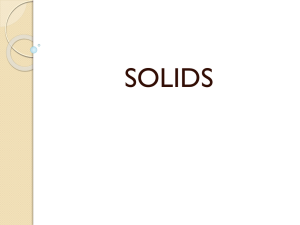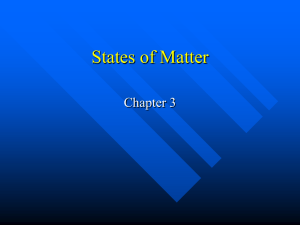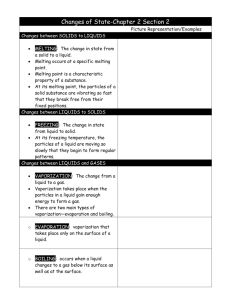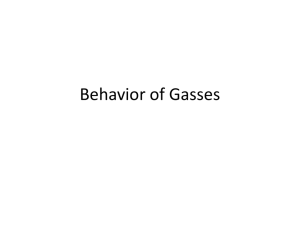States of Matter
advertisement
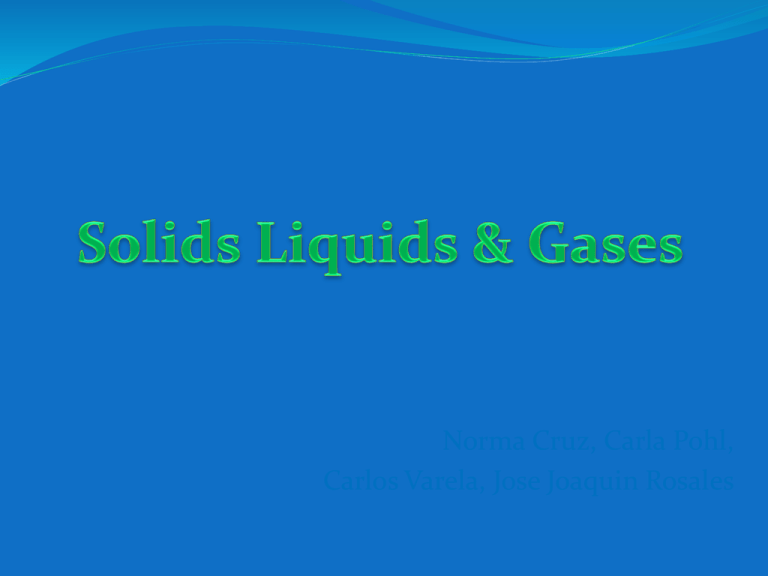
Norma Cruz, Carla Pohl, Carlos Varela, Jose Joaquin Rosales 1. STATES OF MATTER Solid: a substance with a definite shape and volume. Liquid: a substance with a definite volume but no definite shape. Gas: a substance with neither shape or volume. Solids The particles of a solid are packed together and vibrate in the same place. This makes them have a definite shape and volume. There are two types of solids: Crystalline solids Amorphous solids Types of Solids Crystalline Solids: Have a regular repeating pattern that create crystals. They melt at a specific temperature. Amorphous solids: Particles are not in a regular pattern. They do not melt at a specific temperature. They only become softer or change substances. Liquids Liquid particles are packed almost as closely as in a solid. But the particles move around one another freely. Because its particles are free to move, a liquid has no definite shape. But it has a definite volume. Liquids are fluids. A fluid is a substance that flows. Properties of Liquids Liquids have surface tension. Surface tension is the result of an inward pull among the molecules of a liquid that brings the molecule on the surface closer together. Water molecules attract one another strongly together. Another property of liquids is viscosity. Viscosity is a liquid´s resistance to flowing. Gases Gas is a state of matter with no definite shape or volume. As they move, gas particles spread apart, filling all the space available. Gases are also fluids. 2. CHANGES OF STATE MELTING VAPORIZATION Melting Point Solid Boiling Point Liquid FREEZING Gas CONDENSATION SUBLIMATION Changes Between Solid and Liquid Melting is the change in state from a solid to a liquid. Melting occurs at a specific temperature, called the melting. At its melting point, the particles of solid substance are vibrating so rapidly that they break free from their positions. Notice that in the upper left side of the picture shown below, particles are close in fixed positions. When the substance melts, particles move freely like in the lower right side of the picture. Changes Between Solid and Liquid Freezing is the change of state from liquid to solid. At its freezing temperature, the particles of a liquid are moving so slowly that they begin to form regular patterns. The picture below shows how particles change their motion. Changes Between Liquid and Gas Vaporization is a change from liquid to gas. It takes place when the particles of a liquid gain enough energy to form a gas. There are two types of vaporization: Evaporation: Vaporization that takes part only at the surface. Boiling: Boiling occurs when a liquid changes to a gas below its surface as well as at the surface. Changes Between Liquid and Gas Condensation is the change of state from gas to liquid. Occurs when particles in a gas lose enough thermal energy to form a liquid. Changes Between Solid and Gas When particles of a solid gain enough energy that they form a gas state directly is called sublimation. During sublimation, particles of a solid don’t pass through the liquid state as they form a gas. 3. GAS BEHAVIOR When working with a gas, it is helpful to know its volume, temperature, and pressure. Volume is the amount of space that matter occupies. Temperature is the measure of the average energy of motion of the particles of a substance. Pressure is the force exerted on a surface divided by the total area over which the force is exerted (Pressure= Force ÷ Area). Pressure and Volume Scientist Robert Boyle found that when the pressure of a gas at constant temperature is increased, the volume of the gas decreases. When the pressure is decreased, the volume increases. This relationship between pressure and volume of gas is called Boyle’s Law. Pressure and Temperature When the temperature of a gas at constant volume is increased, the pressure of the gas increases. When the temperature is decreased, the pressure of the gas decreases. Volume and Temperature French scientist Jacques Charles found that when the temperature of a gas is increased at constant pressure, its volume increases. When the temperature of a gas is decreased at constant pressure, its volume decreases. This is Charles´s Law. 4. GRAPHING GAS BEHAVIOR Temperature and Volume The graph of Charles´s law shows that the volume of gas is directly proportional to its kelvin temperature under constant pressure. Pressure and Volume The graph of Boyle’s law shows that the pressure of a gas varies inversely with its volume at constant temperature. VOLUME (ML)
